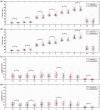Speech Auditory Brainstem Responses in Adult Hearing Aid Users: Effects of Aiding and Background Noise, and Prediction of Behavioral Measures
- PMID: 31264513
- PMCID: PMC6607564
- DOI: 10.1177/2331216519848297
Speech Auditory Brainstem Responses in Adult Hearing Aid Users: Effects of Aiding and Background Noise, and Prediction of Behavioral Measures
Abstract
Evaluation of patients who are unable to provide behavioral responses on standard clinical measures is challenging due to the lack of standard objective (non-behavioral) clinical audiological measures that assess the outcome of an intervention (e.g., hearing aids). Brainstem responses to short consonant-vowel stimuli (speech-auditory brainstem responses [speech-ABRs]) have been proposed as a measure of subcortical encoding of speech, speech detection, and speech-in-noise performance in individuals with normal hearing. Here, we investigated the potential application of speech-ABRs as an objective clinical outcome measure of speech detection, speech-in-noise detection and recognition, and self-reported speech understanding in 98 adults with sensorineural hearing loss. We compared aided and unaided speech-ABRs, and speech-ABRs in quiet and in noise. In addition, we evaluated whether speech-ABR F0 encoding (obtained from the complex cross-correlation with the 40 ms [da] fundamental waveform) predicted aided behavioral speech recognition in noise or aided self-reported speech understanding. Results showed that (a) aided speech-ABRs had earlier peak latencies, larger peak amplitudes, and larger F0 encoding amplitudes compared to unaided speech-ABRs; (b) the addition of background noise resulted in later F0 encoding latencies but did not have an effect on peak latencies and amplitudes or on F0 encoding amplitudes; and (c) speech-ABRs were not a significant predictor of any of the behavioral or self-report measures. These results show that speech-ABR F0 encoding is not a good predictor of speech-in-noise recognition or self-reported speech understanding with hearing aids. However, our results suggest that speech-ABRs may have potential for clinical application as an objective measure of speech detection with hearing aids.
Keywords: Speech-ABR; aided speech-ABR; background noise; hearing aid; speech-in-noise performance.
Figures





Similar articles
-
On prediction of aided behavioural measures using speech auditory brainstem responses and decision trees.PLoS One. 2021 Nov 16;16(11):e0260090. doi: 10.1371/journal.pone.0260090. eCollection 2021. PLoS One. 2021. PMID: 34784399 Free PMC article.
-
Brainstem Evoked Potential Indices of Subcortical Auditory Processing After Mild Traumatic Brain Injury.Ear Hear. 2017 Jul/Aug;38(4):e200-e214. doi: 10.1097/AUD.0000000000000411. Ear Hear. 2017. PMID: 28319479 Free PMC article.
-
Speech Auditory Brainstem Responses: Effects of Background, Stimulus Duration, Consonant-Vowel, and Number of Epochs.Ear Hear. 2019 May/Jun;40(3):659-670. doi: 10.1097/AUD.0000000000000648. Ear Hear. 2019. PMID: 30124503 Free PMC article.
-
Predicting Hearing Aid Satisfaction in Adults: A Systematic Review of Speech-in-noise Tests and Other Behavioral Measures.Ear Hear. 2021 Nov-Dec 01;42(6):1485-1498. doi: 10.1097/AUD.0000000000001051. Ear Hear. 2021. PMID: 33883425
-
Sensory-cognitive interaction in the neural encoding of speech in noise: a review.J Am Acad Audiol. 2010 Oct;21(9):575-85. doi: 10.3766/jaaa.21.9.3. J Am Acad Audiol. 2010. PMID: 21241645 Free PMC article. Review.
Cited by
-
Impact of hearing aid noise reduction algorithms on the speech-evoked auditory brainstem response.Sci Rep. 2020 Jul 1;10(1):10773. doi: 10.1038/s41598-020-66970-2. Sci Rep. 2020. PMID: 32612140 Free PMC article.
-
Effect of digital noise reduction processing on subcortical speech encoding and relationship to behavioral outcomes.Sci Rep. 2025 Jul 1;15(1):22198. doi: 10.1038/s41598-025-07652-9. Sci Rep. 2025. PMID: 40594752 Free PMC article.
-
Predicting Hearing aid Benefit Using Speech-Evoked Envelope Following Responses in Children With Hearing Loss.Trends Hear. 2023 Jan-Dec;27:23312165231151468. doi: 10.1177/23312165231151468. Trends Hear. 2023. PMID: 36946195 Free PMC article.
-
ManCAD100: 100 Years of Audiology and Deaf Education at Manchester.Trends Hear. 2019 Jan-Dec;23:2331216519886239. doi: 10.1177/2331216519886239. Trends Hear. 2019. PMID: 31774038 Free PMC article.
-
On prediction of aided behavioural measures using speech auditory brainstem responses and decision trees.PLoS One. 2021 Nov 16;16(11):e0260090. doi: 10.1371/journal.pone.0260090. eCollection 2021. PLoS One. 2021. PMID: 34784399 Free PMC article.
References
-
- Abrams D., Kraus N. (2015) Auditory pathway representations of speech sounds in humans. In: Katz J., Chasin M., English K., Hood L., Tillery K. (eds) Handbook of clinical audiology, 7th ed Philadelphia, PA: Wolters Kluwer Health, pp. 527–544.
-
- Akhoun I., Gallégo S., Moulin A., Ménard M., Veuillet E., Berger-Vachon C., et al. (2008) The temporal relationship between speech auditory brainstem responses and the acoustic pattern of the phoneme /ba/ in normal-hearing adults. Clinical Neurophysiology 119(4): 922–933. doi:10.1016/j.clinph.2007.12.010. - PubMed
-
- AlOsman R., Giguère C., Dajani H. R. (2016) Effects of stimulus rate and noise on speech-evoked auditory brainstem responses. Canadian Journal of Speech-Language Pathology and Audiology 40(2): 1–16. Retrieved from http://www.cjslpa.ca/detail.php?ID=1195&lang=en.
Publication types
MeSH terms
LinkOut - more resources
Full Text Sources

